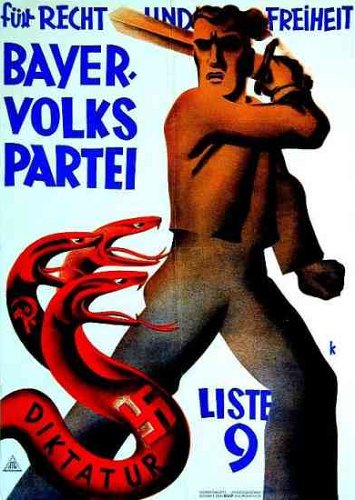Tradition
About Andrew Cusack
 Writer, web designer, etc.; born in New York; educated in Argentina, Scotland, and South Africa; now based in London.
Writer, web designer, etc.; born in New York; educated in Argentina, Scotland, and South Africa; now based in London. read more
News
Blogs
Reviews & Periodicals
Arts & Design
World
France
Mitteleuropa
Knickerbockers
Argentina
The Levant
Africa
Cape of Good Hope
Netherlands
Scandinavia
Québec
India
Muscovy
Germany
Academica
Old Guard on Governors Island

A photo of the Old Guard of the City of New York on Governors Island, with Manhattan in the background, taken on St. George’s Day, 1933. [Click here for larger photo]
Previously: Evacuation Day | Marshal Foch and the Old Guard | A New York Funeral | Old Guardsmen | The Old Guard | Grandpa
Category: New York Militaria
Evacuation Day
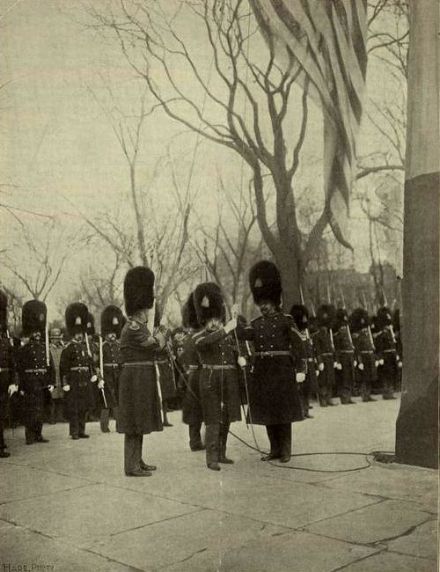
The Old Guard of the City of New York, raising the flag at the Battery on Evacuation Day, 1897. The day commemorates November 25, 1783, when the last royal troops left New York in accordance with the terms of the Treaty of Paris.
Old Dominion Will Receive Her Majesty
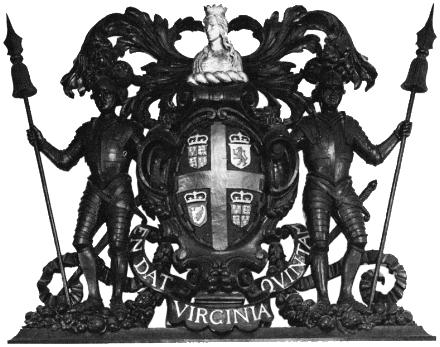
With these words spoken yesterday in the House of Lords, the Queen revealed the plans for her visit to the Commonwealth of Virginia for the upcoming celebrations surrounding the quatercentenary of the first permanent English settlement in the New World. Her Majesty is no stranger to Virginia, nor even to Jamestown, as her very first visit to the New World took place in 1957 when she attended the 350th anniversary celebrations at Jamestown. Following that 1957 official visit to the United States, the Queen opened her parliament at Ottawa for the first time since her accession to the Canadian throne. (more…)
The ‘Day of Fate’
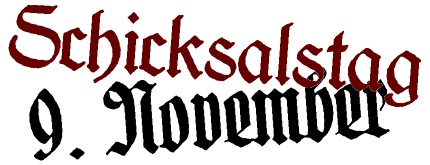
THE NINTH OF November is sometimes known in Germany as ‘Schicksalstag’ or the ‘Day of Fate’ owing to the series of events significant to modern German history which took place on the day in 1848, 1918, 1923, 1938, and 1989.
1918: Kaiser Wilhelm II is dethroned in the November Revolution, marking the end of the German monarchy.
1923: Hitler attempts his failed ‘Beer Hall Putsch’ which signficantly raises the profile of his tiny National Socialist German Workers’ Party.
1938: Synagogues and private property belonging to Jews are violently attacked in the ‘Kristallnacht’ pogrom.
1989: The politburo of Communist East Germany decides to relax the border-crossing restrictions between East and West Germany, leading to the fall of the Berlin Wall.
The first and last events (1848 and 1989) were encouraging events, while the three in between (1918, 1923, and 1938) were progressively worse. Indeed, it could easily be said that 1938 could not have happened without 1923, and that 1923 could not have happened without 1918, so these occurrences are not unrelated.
Children of a Common Mother
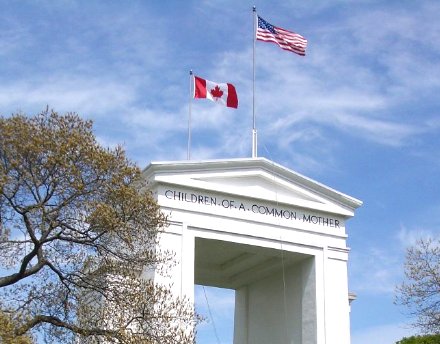
The 22-yard-tall Peace Arch stands between the city of Blaine in Washington state, and the city of Surrey in the province of British Columbia, demarcating the boundary between the United States of America and the Dominion of Canada. The monument, built in 1921, commemorates the 1814 Treaty of Ghent re-establishing peace between the United States and the British Empire.
Cousins

Nicholas II, Tsar of All the Russias and George V, the King Emperor.
Previously: Father & Son | Tennis, Anyone?
Poor Old Bram
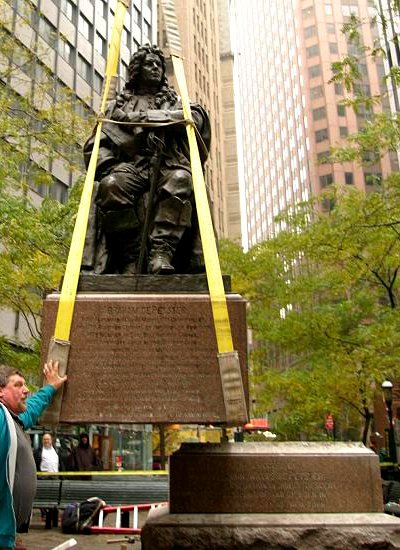
ONE HAS TO FEEL A certain amount of sympathy poor old Abraham de Peyster. The city fathers, in their infinite and unending wisdom, sought fit to erect a statue of Bram in Bowling Green, the old town square of New York down at the beginning of Broadway, many moons ago. However, having set Bram very nicely upon that green, the first public park in all New York, the city fathers have of late refused to let old Heer de Peyster rest. In 1972, the park was ‘renovated’ which entailed the statue’s forced removal. He ended up four years later in Hanover Square, a quite suitable though less prominent location, where he gazed across the square towards India House. It was then that old rivalries flared anew. (more…)
Our Holy Emperor
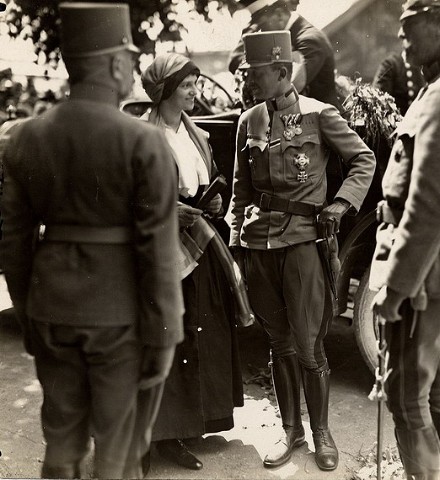
OCTOBER 21 IS the feast of Blessed Charles of Austria, the saintly emperor of that sacred realm whose life stands as an example of the price of sanctity. Charles worked tirelessly for peace both between the peoples of his own numerous realms and between all the nations, seeking to bring to an end the ceaseless and suicidal slaughter of the Great War, in the midst of which he had ascended to the throne of his fathers. A defender of social order, Charles reminds us of our many responsibilities to each other, even though the spirit of our current age would have us clamor only for our supposed rights. In the face of repeated betrayal and intense pressure, he refused to abdicate and so abandon his peoples to their fates, which were terrible indeed. That terrible cross he bore, the crown, was in fact a penitential grace, the sufferings he bore for the benefit of his – and indeed all – people. His reward was not in this world.
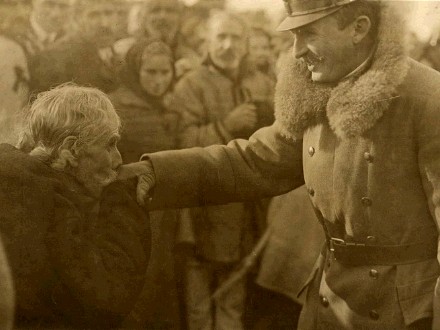
The Duke of York in New York
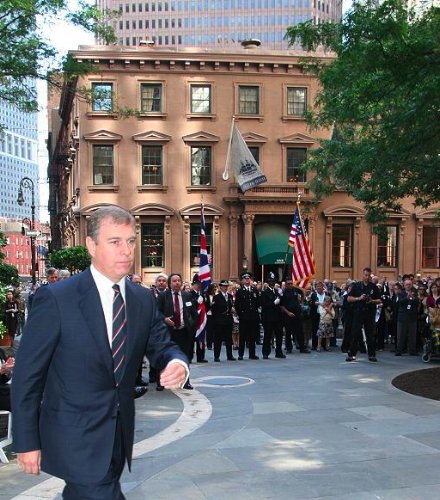
We neglected to mention Prince Andrew’s recent visit to New York in commemoration of the anniversary of the attacks on the World Trade Center. Sixty-seven British subjects died in the September 11, 2001 attacks, and eleven more were non-citizens with British ties. A ceremony was held in Hanover Square, where the British Memorial Garden is being built, followed by a reception at India House, which is located at No. 1 Hanover Square (the brown edifice in the photos above and below). (more…)
James II, Our Catholic King
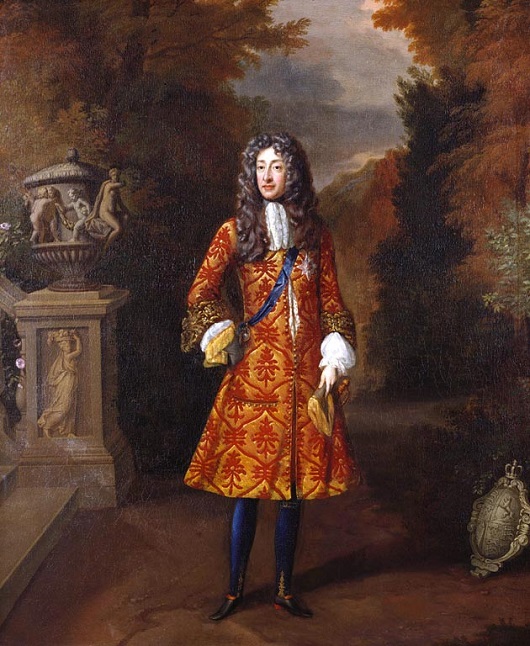
THIS PAST SATURDAY was the anniversary of the birth of King James II and VII of England and Scotland. The third son of Charles I, he was baptised into the Anglican church six weeks after his birth and was created Duke of York at eleven years of age. James married Anne Hyde, the daughter of the Earl of Clarendon, by whom he fathered eight children, though only two survived past childhood.
In 1664 the Duke of York equipped an expedition to relieve the Dutch of responsibility for their colonies in North America, and henceforth New Amsterdam and New Netherland were known as New York after their new Lord Proprietor.
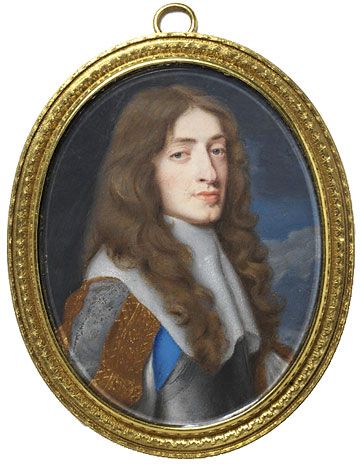
Sometime during the year 1670 both the Duke and Duchess of York were received into the Catholic Church and stopped attending Anglican services, though the conversion did not become public knowledge until the Test Act (requiring officeholders to receive communion in a Church of England service and take an oath against Transubstantiation) was passed three years later. James was forced to renounce his offices, such as Lord High Admiral of England, though not his titles. At any rate, Anne, the Duchess of York had died in 1671 only a year after her conversion. He married Princess Maria of Modena in 1673.
The Protestant oligarchs felt threatened by the prospect of a Catholic king and thrice tried to pass laws barring James from succeeding to the throne. However his elder brother Charles II, the reigning king, dissolved parliament each time before the bill was to be passed. King Charles II died in February 1685, (having reconciled himself to the Catholic faith before his end) and thus the Duke of York was proclaimed James II of England and VII of Scotland. A private Catholic coronation was held at Whitehall Palace on April 22 before the public coronation the following day on the feast of Saint George, which was performed according to the rites of the Church of England.
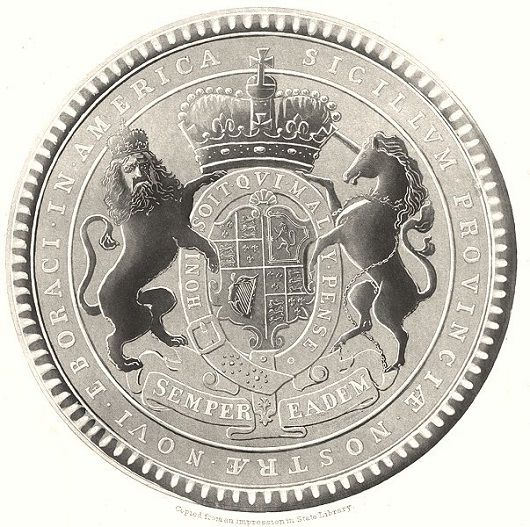
James had appointed the Catholic Thomas Dongan
as Governor of New York in 1682.
The Protestant oligarchs’ fears that James would end their hegemonic grip on Scotland and England proved well-founded as in 1687 he issued a Declaration of Toleration as King of Scotland, allowing Catholics, Episcopalians, and other non-Presbyterians to hold public office and the right of public worship, and a Declaration of Indulgence as King of England removing the laws penalizing non-attendance or non-communion at Church of England services, permitting non-Anglican worship in private homes or chapels, and abolishing religious oaths for public offices. Furthermore, James had allowed Catholics to hold positions at the University of Oxford for the first time since the Protestant Revolution. More provocatively, he tried to transform Magdalen College Oxford into a Catholic seminary. He had already reckoned with the rebellion of the Duke of Monmouth who proclaimed himself king two years earlier but had been captured, tried, and executed for treason. With the birth of a Catholic son and heir, Prince James Francis Edward, in 1688 a cabal of seven Protestant nobles issued an invitation to William of Orange, the Protestant Stadtholder of the Netherlands. A few months later, William of Orange duly arrived and usurped the throne, having already married James’ daughter Mary from his first marriage. The two ruled jointly as William and Mary.
Unwilling to create a popular martyr as had happened with the executed Charles I, William allowed James to escape and fled to France where Louis XIV gave the exiled monarch the use of a palace and an ample pension. James was intent on returning to his birthright, however, and took advantage of the Irish parliament’s refusal to recognise William’s usurpation of the throne. The King landed in Ireland in March of 1689 at the head of a Franco-Irish army but was defeated by William in the famous Battle of the Boyne in July 1690, and returned to his place of exile in France.
There, Louis allowed him to live in the château of Saint-Germain-en-Laye and offered to get James elected King of Poland but James felt this would prevent any chance of a Stuart again holding the throne of England. From that time onwards, James led a simple life of penance in reparation for his sins (he had had a number of mistresses in his younger days) and finally died in 1701. He was entombed in the Chapel of St. Edmund within the English Benedictine church on the Rue St. Jacques in Paris, while his brain was sent to the Scots College in Rome, his heart to the Visitandine Convent at Chaillot, and his bowels divided between the College of St. Omer (the exiled English Catholic school, now Stonyhurst in Lancashire), and the nearby parish church of St. Germain where they remained until they were desecrated by a Revolutionary mob and lost forever. His monument at Saint-Germain, however, was rediscovered in 1824 and is proudly displayed there to this day. There is also a monument to James and the Stuarts in St. Peter’s Basilica in Rome (c.f. Roma – Caput Mundi).
Aside from the pious tradition that Edward VII was received into the Church on his deathbed, James II was the last Catholic king (and as good King Edward never reigned over New York, James is even more certifiably so for us). There is a lovely coronation ode to James which I just might bring to your attention someday. But for now, reflect and remember our monarchs of old and pray that God in His mercy might grant us good Catholic rulers in stead of the shabby lot we elect today.
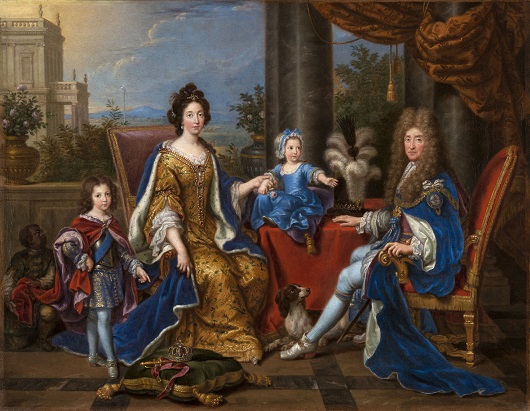
Old Yale Boathouse Faces Wrecking Ball
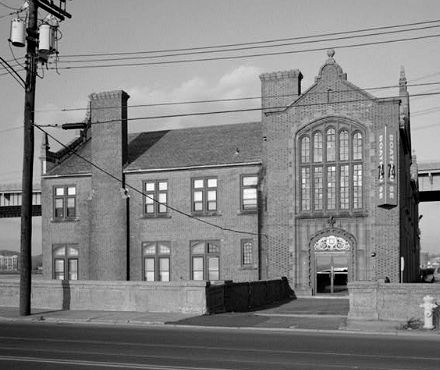
AND SO, THE ONWARD march of progress continues. Yale University’s old Adee Boathouse on New Haven harbor is to face the wrecking ball to make way for traffic improvements to the Pearl Harbor Memorial Bridge which carries Interstate 95 across the Quinnipiac River. Despite some quite extraordinary plans to physically cut the building from the shore and float it across to the opposite side of the river, it now appears that the boathouse is to be demolished. (more…)
Goosesteps and Pickelhaubes
The Republic of Chile’s Annual ‘Parada Militar’
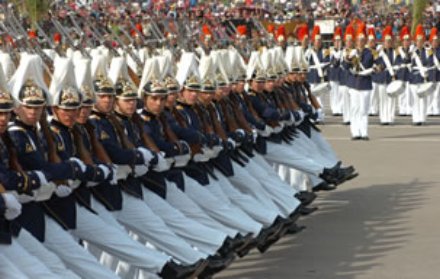
WHILE MANY NATIONS have thrown time-honored traditions and ceremonies to the wind, they remain central to the South American nation of Chile. Through the wisdom of its leaders, be they civil, military, Liberal, Conservative, Radical, Socialist, or Christian Democrat, this republic on the Pacific has not sampled the bitter taste of war since 1883 when they snatched the last remnants of Bolivia’s coastline. (Bolivia, now landlocked and ever holding a grudge, still maintains a small navy in defiance of geography). Having steered clear of the suicidal bloodlust which consumed much of the Western world during the Twentieth Century (say what you will about the deaths of the Allende/Pinochet years, they are far fewer than our dead of the World Wars, Korea, and Vietnam), Chile feels free to continue in the best of its European traditions free from emotional hangups.
For we in the Anglo-American world, goosesteps and pickelhaubes evoke nasty images of Prussian militarism and Nazi hegemony. While the pickelhaube is actually of Prussian origin, having been designed in 1842 by Frederick William IV, the revolutionary Hitler eventually banished them as fusty remnants of the ancien regime. And, while Hitler did popularize the goosestep, this particular form of march has its origins in old Imperial Russia.
Chile is a nation composed of settlers from almost every European country, and has adapted and melded its traditions and culture thencefrom. The ‘Father of the Country’ was an Irishman by the name of Bernardo O’Higgins, while the founder of the Chilean Navy was the 10th Earl of Dundonald. Later immigrants brought influence from Germany, Italy, and other countries, while the founding influence of Spain remained.
Every year, Chile celebrates the ‘Day of the Glories of the Armed Forces’ on September 19, the day following Chile’s Independence Day of September 18 commemorating the 1810 junta. The civil leaders of the land and high-ranking military officers assemble at a stand on the Campos de Marte in the Parque O’Higgins in Santiago and review a long parade of the Army, the Navy, the Air Force, and the Carabineros, Chile’s gendarmerie-style national police.
I’ve always loved a parade, and there is no parade like a military parade, so I decided to share with you a few views of Chile’s annual parada militar. One gets the impression that just before we put the Third Reich out of business, they contracted a huge surplus uniform sale to the Chileans which has left them a bountiful supply of uniforms to this day. Indeed, judging by some of the uniforms, one might even get the impression that the same happened earlier in the century when we (lamentably) forced the Kaiser to close shop. But the Chileans will continue to wear their uniforms with pride, and who can blame them? They look good. (more…)
Birds of a Feather?
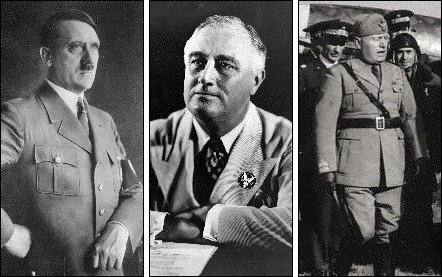
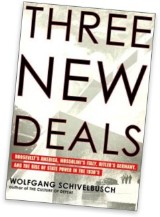 Were Hitler, Roosevelt, and Mussolini really just different cuts of the same cloth? In a new book, Three New Deals: Reflections on Roosevelt’s America, Mussolini’s Italy, and Hitler’s Germany, 1933-1939, Wolfgang Schivelbusch makes precisely that argument. Interestingly, the National Socialists in Germany looked with fondness towards Roosevelt’s style of rule. The Nazi party newspaper Völkischer Beobachter actually praised “the adoption of National Socialist strains of thought in his economic and social policies” while Mussolini also saw a bit of himself in FDR. Roosevelt wouldn’t give the time of day to Herr Hitler but was actually quite fond of Signor Mussolini, calling him “that admirable Italian gentleman”.
Were Hitler, Roosevelt, and Mussolini really just different cuts of the same cloth? In a new book, Three New Deals: Reflections on Roosevelt’s America, Mussolini’s Italy, and Hitler’s Germany, 1933-1939, Wolfgang Schivelbusch makes precisely that argument. Interestingly, the National Socialists in Germany looked with fondness towards Roosevelt’s style of rule. The Nazi party newspaper Völkischer Beobachter actually praised “the adoption of National Socialist strains of thought in his economic and social policies” while Mussolini also saw a bit of himself in FDR. Roosevelt wouldn’t give the time of day to Herr Hitler but was actually quite fond of Signor Mussolini, calling him “that admirable Italian gentleman”.
That there were massive differences between the three is obvious. (Mussolini and Hitler came to the brink of war over Austria, and later they both had a war with Roosevelt). Nonetheless, the similarities are worth pointing out, and David Gordon has written a review of the book over at the Ludwig von Mises Institute. Give it a read.
Heraldry is as much part of the future as present
by JOHN HALDANE
THE SCOTSMAN | Saturday 9 September 2006
A COUPLE of weeks ago St Andrews was treated to the sight of a colourful parade of heralds, hereditary standard bearers, nobility and clan chiefs, representatives of the University, leaders of the Christian churches, and sundry others, processing through the town to the accompaniment of the pipes. The occasion was the opening by the Princess Royal of the 27th International Congress of Genealogical and Heraldic Sciences, featuring the first meeting of European heralds since the middle ages.
This weekend St Andrews sees another ritual procession: this of Knights and Dames of the Equestrian Order of the Holy Sepulchre gathering for an investiture in the 15th century chapel of St Salvator’s College. Once again gowns, insignia, and banners of medieval inspiration will be on view as Scottish members are joined by representatives from abroad and from the Sovereign Military Order of St John – with the pipes again adding a distinctively Caledonian note.
Such events, and the groups and individuals they bring together can easily be seen as part of a world of childlike, or even childish, fantasy. Trying to live as if in a realm of castles, chivalarous knights, noble heroes, fair ladies, courtly love and sacred adventures, all rendered for posterity in chronicles and ballads.
Centro Naval, Buenos Aires
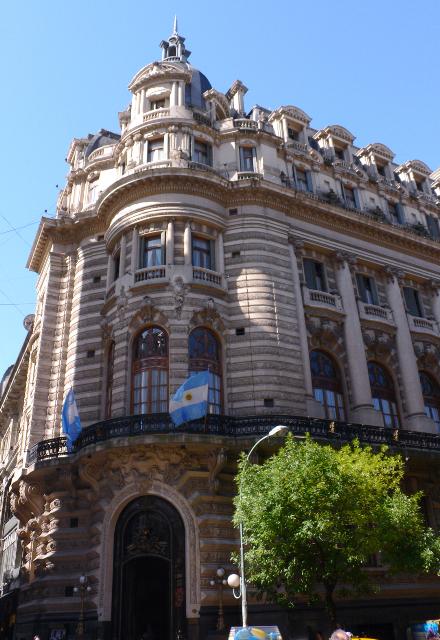
OUR GOOD FRIEND Tori Truett sends greetings from Buenos Aires where she is visting relatives and her salutation sparked a number of memories from my all-too-short time down there. One of these memories was being relieved upon by a bird whilst pottering about the market of San Telmo one afternoon (it remains the only time I have suffered the indignity of such an aerial bombardment). The good city, however, has more beautiful buildings than the Big Apple, both in quality and quantity. Their good buildings are better than ours, but then their ugly buildings are even uglier. (As terrible as the Whitney Museum is, I doubt it matches the Biblioteca Nacional for sheer vulgarity). (more…)
The Heraldic Congress
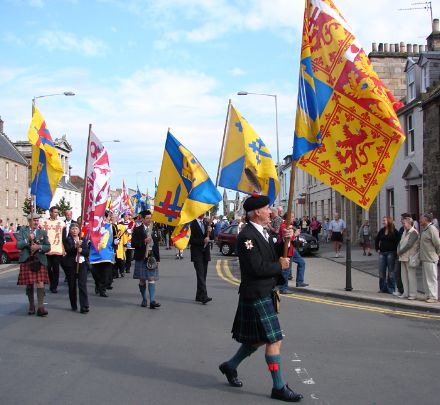
THE ROYAL BURGH of St Andrews was recently host to the largest gathering of heralds since the Middle Ages for the XXVII International Congress of Genealogical and Heraldic Sciences. Taking place in the last week of August, the Congress was opened with a grand ceremony in the University’s Younger Hall which was attended and addressed by the XXVII Congress’s patron, the Princess Royal (Scottish arms below). The event lured state heralds, genealogists, heraldists, and other enthusiasts from around the world, as well as local heralds from the Court of Lord Lyon (Scotland’s heraldic authority) and the personal heralds of Scots noble houses. Aside from the ceremonial, a broad variety of lectures were given on various topics in the realm of heraldry and genealogy. We present to you here a number of photographs from the event, which have been taken from the Congress website as well as from the personal collections of Mr. John Gaylor, a member of the Heraldry Society of Scotland, and Mr. David Appleton of the American Heraldry Society.
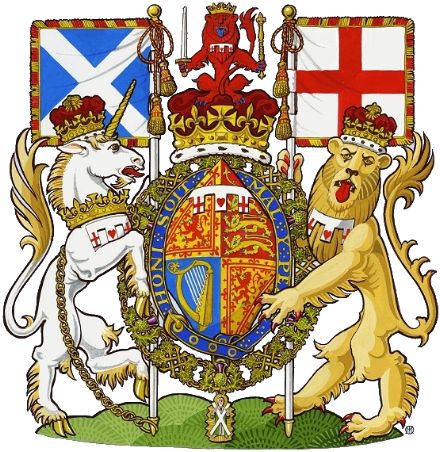
The Jefferson Guards
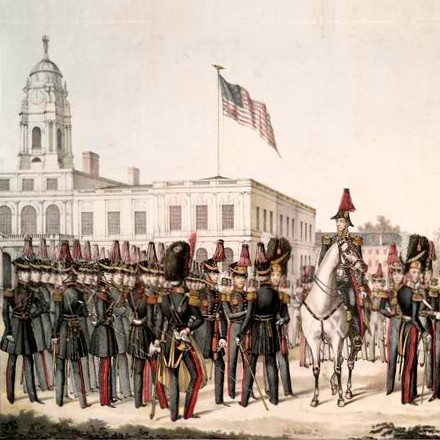
I recently stumbled upon this image depicting a militia regiment gathered in front of New York’s City Hall. The unit in question is the Jefferson Guards, 38th Regiment, New York State Artillery, amassed in bearskin caps and red-plumed shakos (red being the traditional color of the artillery). I confess I’d never heard of the Jefferson Guards before, but this is not entirely surprising. The Armed Forces of the State of New York – today composed of the New York Army National Guard, the New York Air National Guard, the New York Guard, and the New York Naval Militia – was once composed of a vast array of assorted regiments, battalions, and companies (a quite literal example of the ‘little platoons’ praised by Burke). These militia companies varied greatly in form, from little more than glorified social clubs to the crack units of the day.
As strange as it may seem, considered as a whole they were an almost completely organic military and, while they would be ill-suited to the armed exigencies of today, I refuse to believe that our little realm is better off for their general disappearance. Certainly the V.C.A. and the Old Guard, among others, survive to this day (in a somewhat different form, naturally), but what of the Empire Light Cavalry and the German Horse Guards? The Ulster Guard, the Weschester Chasseurs, and the New York Highlanders? The gallant Seventh Regiment of New York survived even into the 1990’s before its dissolution was ensured by the monotony monitors who now, fifteen years later, seek to destroy the great and blessed monument of an armory on Park Avenue which the Seventh built and guarded for over a century. We mourn their disappearance, just as we detest the continued and increasing disdain for the proud military heritage of the City and State of New York, but the entire culture which created and sustained them is gone, too.
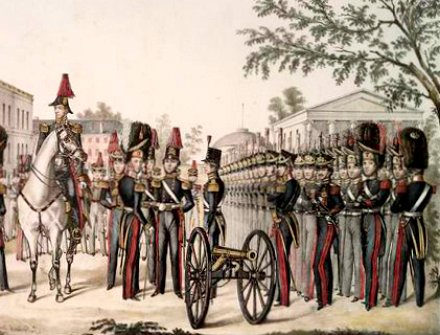
Category: Militaria – New York
A Scene at the Club
Punch, 28 July, 1920
I never liked Buttinbridge. I considered him a vulgar and pushful fellow. He had thrust himself into membership of my club and he had forced his acquaintance upon me.
I was sitting in the club smoking-room the other day when Buttinbridge came in. His behaviour was characteristic of the man. He walked towards me and said in a loud voice, “Cheerioh, old Sport!”
I drew the little automatic pistol with which I had provided myself in case of just such an emergency, took a quick aim and fired. Buttinbridge gave a convulsive leap, fell face downwards on the hearthrug and lay quite still. It was a beautiful shot—right in the heart.
The room was fairly full at the moment, and at the sound of the shot several members looked up from their newspapers. One young fellow—I fancy he was a country member recently demobilised—who had evidently watched the incident, exclaimed, “Pretty shot, Sir!” But two or three of the older men frowned irritably and said, “Sh-sh-sh!”
Seeing that it was incumbent upon me to apologise, I said, in a tone just loud enough to be audible to all present, “I beg your pardon, gentlemen.” Then I dropped the spent cartridge into an ash-tray, returned the pistol to my pocket and was just stretching out my hand to touch the bell when old Withergreen, the doyen of the club, interposed.
“Pardon me,” he said, “I am a little deaf, but almost simultaneously with the fall of this member upon the hearthrug I fancied I heard the report of a firearm. May I claim an old man’s privilege and ask if I am right in presuming a connection between the two occurrences, and, if so, whether there has been any recent relaxation of our time-honoured rule against assassination on the club premises?”
Shouting into his ear-trumpet, I said, “I fired the shot, Sir, which killed the member now lying upon the hearthrug. I did so because he addressed me in a form of salutation which I regard as peculiarly objectionable. He called me ‘Old Sport,’ an expression used by bookmakers and such.”
“Um! Old Port?” mumbled old Withergreen.
“Old Sport,” I shouted more loudly. Then I stepped to the writing-table, took a dictionary from among the books of reference, found the place I wanted and returned to the ear-trumpet.
“I find here,” I said, for the benefit of the room at large, for all were now [pg 75] listening, though with some impatience, “that in calling me a ‘sport’ the deceased member called me a plaything, a diversion. If he had called me a sportsman, which is here defined as ‘one who hunts, fishes or fowls,’ he would have been not necessarily more accurate but certainly less offensive.”
At this point there stood up a member whom I recognised as one of the committee. “I am sure, Sir,” he said, “that all present are agreed that you fired in defence of the purity of English speech, and that the incident was the outcome of an unfortunate attempt to relieve the financial embarrassment of the club by relaxing our former rigorous exclusiveness. Speaking as one of the committee, I have no doubt that the affair will be dismissed as justifiable homicide.”
Having bowed my acknowledgments I rang the bell. When the waiter appeared I bade him “Bring me a black coffee and then clear away the remains of Mr. Buttinbridge.”
Then I was awakened by the voice of Buttinbridge yelling, “Wake up, old Sport!”
‘We Stand By You’
Old Europe Lives?
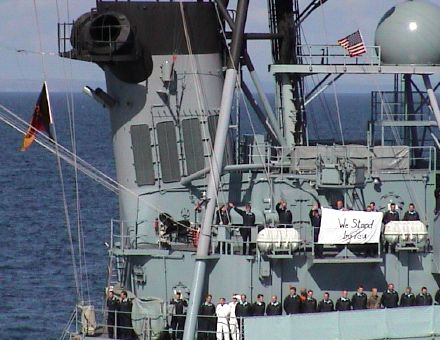
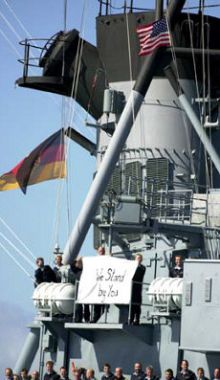 An incident took place at sea on September 14, 2001, just a few days after the attacks on New York and Washington, which has not been widely recounted. In the time leading up to September 11, the U.S.S. Winston S. Churchill was in port in Plymouth, England, where it was moored next to the Lütjens of the German Navy. During their time in port together, the officers and crews of the Churchill and the Lütjens had combined for a number of lively convivial undertakings in the generous spirit of friendship and brotherhood. After the attacks, however, Churchill immediately put to sea to perform a number of drills while maneuvering back in forth in the same area.
An incident took place at sea on September 14, 2001, just a few days after the attacks on New York and Washington, which has not been widely recounted. In the time leading up to September 11, the U.S.S. Winston S. Churchill was in port in Plymouth, England, where it was moored next to the Lütjens of the German Navy. During their time in port together, the officers and crews of the Churchill and the Lütjens had combined for a number of lively convivial undertakings in the generous spirit of friendship and brotherhood. After the attacks, however, Churchill immediately put to sea to perform a number of drills while maneuvering back in forth in the same area.
“It hasn’t been that fun I must confess,” an ensign aboard the Churchill wrote home, “and to be even more honest, a lot of people are frustrated at the fact that they either can’t be home, or we don’t have more direction right now. We have seen the articles and the photographs, and they are sickening. Being isolated as we are, I don’t think we appreciate the full scope of what is happening back home, but we are definitely feeling the effects.”
“About two hours ago the junior officers were called to the bridge to conduct Shiphandling drills. We were about to do a man overboard when we got a call from the Lutjens. […] Now at sea they called over on bridge-to-bridge, requesting to pass us close up on our port side, to say good-bye.”
“We prepared to render them honors on the bridgewing, and the Captain told the crew to come topside to wish them farewell. As they were making their approach, our Conning Officer announced through her binoculars that they were flying an American flag. As they came even closer, we saw that it was flying at half-mast. The bridgewing was crowded with people as the Boatswain’s Mate blew two whistles – Attention to Port – the ship came up alongside and we saw that the entire crew of the German ship were manning the rails, in their dress blues. They had made up a sign that was displayed on the side that read ‘We Stand By You’.”
As the ensign wrote later in the email, “It’s amazing to think that only a half-century ago things were quite different,” and it’s interesting to note that both ships are named after figures from the Second World War; Winston Churchill the half-American Prime Minister of Great Britain, and Günther Lütjens the admired German Admiral who died aboard the Bismarck.
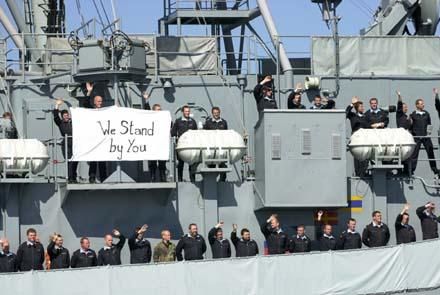
Search
Instagram: @andcusack
Click here for my Instagram photos.Most Recent Posts
- Amsterdam November 26, 2024
- Silver Jubilee November 21, 2024
- Articles of Note: 11 November 2024 November 11, 2024
- Why do you read? November 5, 2024
- India November 4, 2024
Most Recent Comments
- on The Catholic Apostolic Church, Edinburgh
- on Articles of Note: 11 November 2024
- on Articles of Note: 11 November 2024
- on Why do you read?
- on Why do you read?
- on University Nicknames in South Africa
- on The Situation at St Andrews
- on An Aldermanian Skyscraper
- on Equality
- on Rough Notes of Kinderhook
Book Wishlist
Monthly Archives
Categories

